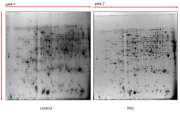Proteomics analysis of drought responsive proteins in ammopiptanthus mongolicus

In this project, Ammopiptanthus mongolicus, a typical desert plant, is taken as the research object. Through optimizing the protein extraction and purification system of Ammopiptanthus mongolicus, IEF and 2-D two-dimensional electrophoresis techniques are used to obtain soluble protein electrophoresis maps of Ammopiptanthus mongolicus, and protein spots differentially expressed under drought stress are analyzed and obtained, which provides technical guarantee for subsequent mass spectrometry to identify protein functions and construct Ammopiptanthus mongolicus water stress response network.
Data Citations
Cite as:Su, Y. (2016). < b>Proteomics analysis of drought responsive proteins in ammopiptanthus mongolicus</b>2016. doi: 10.3972/heihe.207.2014.db. (Download the reference: RIS | Bibtex )
Using this data, the data citation is required to be referenced and the related literatures are suggested to be cited.
Terms of Use
To respect the intellectual property rights, protect the rights of data authors, expand services of the data center, and evaluate the application potential of data, data users should clearly indicate the source of the data and the author of the data in the research results generated by using the data (including published papers, articles, data products, and unpublished research reports, data products and other results). For re-posting (second or multiple releases) data, the author must also indicate the source of the original data.
Support Program
None
Related Resources
1.The leaf water potential dataset in the downstream of the Heihe River Basin (2012)
2.HiWATER: the albedo in the middle reaches of the Heihe River Basin (Jun. 29, 2012)
3.Grassland interception dataset of Tianlaochi watershed in Qilian Mountain
4.HiWATER: Dataset of infrared temperature in Zhanye Airport desert
7.HiWATER: Airborne CCD image data in Hulugou Catchment
9.Leaf area index of Qinhai spruce stand at 2800 m above sea level in Pailougou watershed (2011)
No record
No record
Comments
Sign In to add comments

 Copyright ©right; 2017 - 中国科学院西北生态环境资源研究院 - 兰州数云软件科技有限公司提供技术支持
Copyright ©right; 2017 - 中国科学院西北生态环境资源研究院 - 兰州数云软件科技有限公司提供技术支持